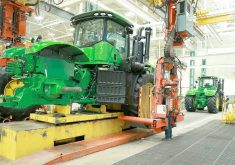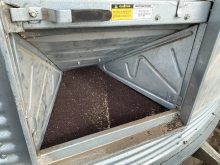A select committee of experts has released a report on the E. coli outbreak at the former XL Foods beef plant in Brooks. The committee was created by the federal government to find a cause for the outbreak and to make some recommendations to avert such a fiasco in the future.
This investigation was demanded by most of the cattle organizations, but curiously was resisted by the Alberta government, which said there was no need for an investigation every time there was a food safety problem. There is some truth to that, but the threshold for such an investigation seemed to have been set very high by the provincial government if the XL outbreak was any example.
Read Also

Farm equipment sales sector sees significant structural changes
Farming equipment sales have been declining for a number of years now, and one industry professional believes structural changes in the industry are needed to curb that trend.
In effect the report blamed both sides for an atmosphere of complacency within the plant and a cosy relationship between management and CFIA staff. That’s a surefire recipe for laxity and all but guarantees that something will slip through the system. When that occurs the only hope to avoid a bigger problem is luck, and for the XL plant it seems its luck just ran out.
From what leaked out during the crisis, it was alleged that management was probably not as diligent as it should have been. It was also reported back then that many of the CFIA inspectors may not have been trained to the highest standards.
What is clear is that the CFIA response to the outbreak was over the top. The beef recall, destruction and waste of so much product seemed at many times to be done more on whim than any scientifically accepted protocol. There needs to be a firm recall standard established and it needs to be applied to any outbreak of food pathogens. What we have at present is an obvious bias by food inspection authorities against beef. At almost the same time of the XL outbreak, one person died and many others got sick from E.coli in packaged lettuce. Yet it would seem our inspection authorities almost covered up that outbreak, there was little recall of the product and no real consequences for the lettuce packager.
The expert report did bring to light a food safety matter that has been discussed by the industry for at least 30 years, and that’s the use of irradiation. The report suggested that this process be considered to add another layer of food safety in the beef processing system. You would be hard pressed to find anyone involved in the entire chain who would not agree that the use of irradiation on beef is long overdue. The big exception to that common sense is not surprisingly the federal government. The biggest culprit being Health Canada, who for over 10 years managed to block the approval of the process. It boggles the mind considering the sickness and death that could have been avoided had the process been promptly approved.
In the end the report was of value and highlighted procedural and administrative problems that are resolvable. Even better, the new owners of the plant, JBS Canada, intend to install their own food safety standards which are even higher than those of the CFIA. That would indeed be a very good outcome for what was a bad situation.














